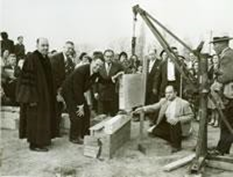Temple Emanu El History
 In the summer of 1947, a new congregation was formed to fulfill a long felt need to have a Reform presence in the Heights area. With the sponsorship of the Union of American Hebrew Congregation (now renamed the Union for Reform Judaism), and direct assistance from The Temple-Tifereth Israel and Anshe Chesed Fairmount Temple, Temple Emanu El was created.
In the summer of 1947, a new congregation was formed to fulfill a long felt need to have a Reform presence in the Heights area. With the sponsorship of the Union of American Hebrew Congregation (now renamed the Union for Reform Judaism), and direct assistance from The Temple-Tifereth Israel and Anshe Chesed Fairmount Temple, Temple Emanu El was created.
 Dr. Alan S. Green, who was associated with a congregation in Texas, was named rabbi and was to grace our pulpit for thirty years. Irvin Bushman became the first cantor, serving in that capacity from 1947 to 1983. When Religious School Principal Sophie Herman was hired, she became the third pillar of the priad of incredible leadership.
Dr. Alan S. Green, who was associated with a congregation in Texas, was named rabbi and was to grace our pulpit for thirty years. Irvin Bushman became the first cantor, serving in that capacity from 1947 to 1983. When Religious School Principal Sophie Herman was hired, she became the third pillar of the priad of incredible leadership.
The new congregation originally met for meetings at the corner of Lee and Van Aken Roads at Moreland School. The founders envisioned a vibrant temple filled with warmth, music, and tradition.
The earliest members were primarily young, enthusiastic, post-war families living in the epicenter of what was to become a new Jewish neighborhood – the Heights. These families came to embrace their Judaism in a very special way. As a result, the congregation grew rapidly, drawing members from the surrounding neighborhoods.
TEE offered a full array of vibrant programs and services as well as a Religious School. The school stressed the joy of Judaism and taught students that faith could make a major contribution to the community and to mankind.
One year after its founding, TEE had a membership of 350 families and a religious school filled with 250 students. By the end of the second year, 500 families had joined the temple and by the end of the third, the school reached an enrollment of 500. During the early years, worship services and special programs were held at both Plymouth Church and the chapel on the Bellefaire campus.
 In June of 1950, land was acquired in University Heights to build TEE’s first home. Construction began with a flourish. Ground was broken in 1951; the cornerstone laid in 1952; and the dedication of our beautiful new building in 1954. The congregation had a modest mortgage which was paid off soon after the new building opened.
In June of 1950, land was acquired in University Heights to build TEE’s first home. Construction began with a flourish. Ground was broken in 1951; the cornerstone laid in 1952; and the dedication of our beautiful new building in 1954. The congregation had a modest mortgage which was paid off soon after the new building opened.
TEE enjoyed terrific growth for many years. Rabbi Green, who served the congregation until his retirement in 1977, was known as an inspiring leader, a builder of spiritual values, a scholar, a magnificent educator, a visionary and a dedicated leader who attracted many prominent as well as previously unaffiliated families to Temple Emanu El. He was a champion of interfaith and interracial understanding and worked tirelessly to unite people of different faiths and races because he believed it was vital for people to respect each other and to be understood.
 In October of 1977, Rabbi Green passed the torch to the then assistant rabbi, Daniel Roberts. Rabbi Roberts served as the senior rabbi for 25 years. During his tenure, TEE continued to thrive and our reputation as a beacon of understanding for interfaith and interracial programming grew. Rabbi Roberts introduced premarital counseling for all couples, was committed to working with the Temple’s youth and families and became a well-known expert the area of death and dying and teen suicide.
In October of 1977, Rabbi Green passed the torch to the then assistant rabbi, Daniel Roberts. Rabbi Roberts served as the senior rabbi for 25 years. During his tenure, TEE continued to thrive and our reputation as a beacon of understanding for interfaith and interracial programming grew. Rabbi Roberts introduced premarital counseling for all couples, was committed to working with the Temple’s youth and families and became a well-known expert the area of death and dying and teen suicide.
During Rabbi Roberts’ tenure, the Temple established a child care center which was an instant success. Not only did the center earn an excellent reputation for the care it provided, but it showcased TEE for the unaffiliated families who brought their children there. Many new members are still introduced today through the TEE Preschool.
At the end of the 1990’s, the demographics of the Cleveland Jewish community had shifted significantly by this time. What was once the center of Jewish Cleveland was not any longer. Though many families continue to live in the inner ring suburbs of Cleveland and University Heights, South Euclid, Lyndhurst, and Shaker Heights, they are not young, Reform families with school-aged children. Since 1985, TEE was forced to face a downward trend in its membership and school enrollment.
 According to the demographic study by the 2004 Jewish Community Federation, 40.6% of the Jewish community lived in the eastern and southeastern suburbs of Beachwood, Pepper Pike, Orange Village, Chagrin Falls, Solon and Twinsburg compared to just 24% in 1996. Comparisons of our Religious School enrollment verified the demographic findings. The 2011 Jewish Community Federation demographic study now shows that as much as two-thirds of those with children aged 0-17 now live in the east side suburbs and Solon/southeast suburbs. Since 1996, the east side suburbs, Beachwood, and Solon/southeast suburbs have experienced the greatest Jewish growth in Cleveland with a 44% increase.
According to the demographic study by the 2004 Jewish Community Federation, 40.6% of the Jewish community lived in the eastern and southeastern suburbs of Beachwood, Pepper Pike, Orange Village, Chagrin Falls, Solon and Twinsburg compared to just 24% in 1996. Comparisons of our Religious School enrollment verified the demographic findings. The 2011 Jewish Community Federation demographic study now shows that as much as two-thirds of those with children aged 0-17 now live in the east side suburbs and Solon/southeast suburbs. Since 1996, the east side suburbs, Beachwood, and Solon/southeast suburbs have experienced the greatest Jewish growth in Cleveland with a 44% increase.
Fifty years after TEE dedicated its original building, the congregational leadership took a hard look at the possibility of relocating or merging with another congregation. In 2000, a committee called Decision 2000 was formed and determined that they “needed to fix what was under the roof, not where the roof was located” and the decision to move was postponed.
When Rabbi Roberts transitioned to emeritus status, a new rabbi, Andrew Paley, joined for three years. Rabbi Steven Denker was brought on board in 2004 as the interim rabbi. Two years later, he became senior rabbi. Rabbi Denker helped the leadership analyze our situation, evaluate options, and plan for the future. The Board of Trustees carefully evaluated 3 strategic options outlines – become smaller, merge with another synagogue, or relocated.
 Merging with another congregation was quickly dismissed. Staying at the Green Road location and maintaining a presence in the Heights was desirable to some, although staying put would mean a continued decline in membership and religious school enrollment. After months of study, it was determined that relocation was the best option to preserve our congregation.
Merging with another congregation was quickly dismissed. Staying at the Green Road location and maintaining a presence in the Heights was desirable to some, although staying put would mean a continued decline in membership and religious school enrollment. After months of study, it was determined that relocation was the best option to preserve our congregation.
Some congregants saw relocating as a leap of faith. Others knew that a move east per the demographic studies was in fact the proper direction as the center of the Jewish community was no longer the Heights area. Available parcels of land south of Chagrin Boulevard and east of Richmond Road were examined. The site selected was almost eleven acres of gently rolling land, abutted by trees at the intersection of Brainard and Emery Roads in Orange Village. The sale of the property closed in May of 2005.
 During the summer of 2005, demolition of the seven structures on the new property took place. Over the next three years, the new Temple Emanu El facility took shape. The new building was designed to take advantage of its natural setting and allow for plenty of sunlight. The building includes many features including:
During the summer of 2005, demolition of the seven structures on the new property took place. Over the next three years, the new Temple Emanu El facility took shape. The new building was designed to take advantage of its natural setting and allow for plenty of sunlight. The building includes many features including:
- Spacious sun-filled Atrium upon entering the building to provide for meaningful gathering
- Sanctuary seating for 245 that can be expanded to 800 and a more intimate Chapel seating 100 to provide for formal and informal worship services
- Religious School including an open Library and Youth Lounge
- Preschool including two outdoor Playgrounds, an Activity Room and Music Room
- Outdoor Gardens and a stone Terrace

After 18 years of service, Rabbi Denker retired in May 2022. In November 2021, the Rabbinic Search Committee unanimously recommended Rabbi Matt Cohen – currently a Senior Rabbi in Galveston, TX but originally from around the corner in Beachwood – to the Board of Trustees as Temple Emanu El’s next senior rabbi. The Board approved the hiring of Rabbi Cohen who started on July 1, 2022.
The Religious School continues to have an enviable 70% retention rate after B’nai Mitzvah, well above the national average. The Preschool — accommodating children 6 weeks through pre-kindergarten — has also gained momentum, making it necessary to add several new classrooms to accommodate our current 45 student enrollment.

Active and growing adult groups, like the Brotherhood and Women of Temple Emanu El, keep members involved. Each year, participation at social function rises.
Our location, size and sense of community attract and welcome the growing number of interfaith families in the Cleveland area. TEE is the only full-service mid-size Reform congregation servicing the eastern and southern suburbs of Cleveland as well as the Jewish community of western Geauga, northwestern Portage and northern Summit counties. The future is very bright for TEE in all aspects. We continue to engage our entire congregation in expanded programming, meaningful worship experiences, and innovative education for all ages.

